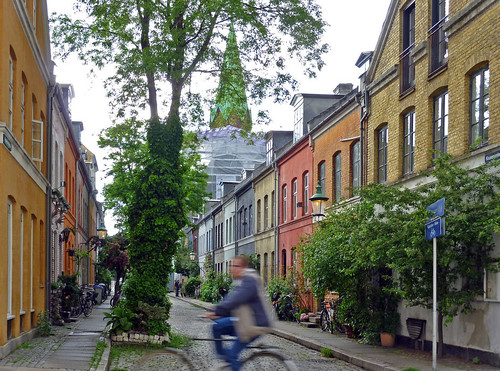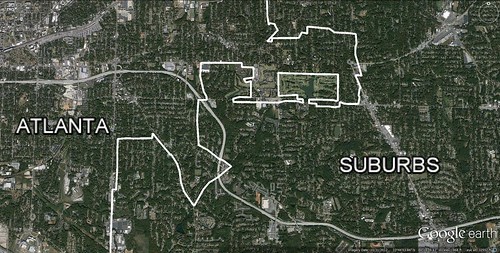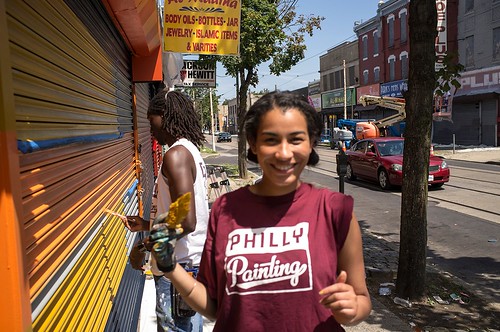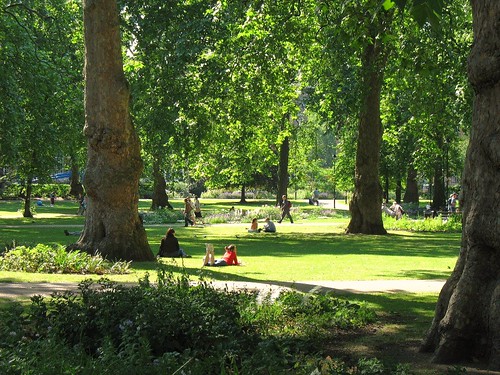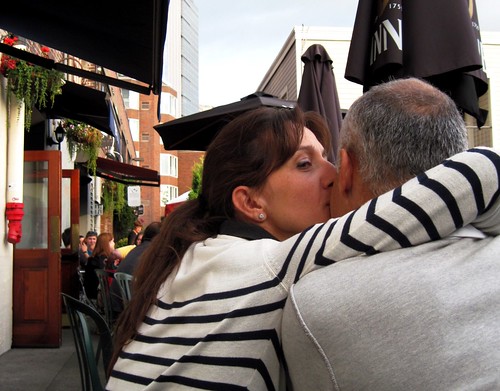Five ways to think about greener, healthier cities

Posted January 13, 2014 at 1:30PM
I like to consider “people habitat” – the realm of places that humans build and inhabit – as having an ecology of its own, roughly analogous to that of natural wildlife habitat. Nature works best when it is in balance and, like the natural environment when operating at its best, the built environment created by us humans should achieve harmony among its various parts and with the larger world upon which it depends. But, while the ecology of the natural world – at least as usually studied – concerns itself primarily with the interdependence and health of non-human species, the ecology of people habitat concerns itself also with our relationships as humans to each other, and with the health of communities that support those relationships and allow us to flourish alongside and within nature.
I believe we humans have an opportunity and a duty to make our habitat work both for us as people and for the sustainable health of the planet writ large. Indeed, if our solutions do not work for people, they will never work for the planet.
I would like to posit five principles that, for me at least, help frame a positive, solution-oriented approach to thinking about the built environment, the habitat we make for people. They certainly aren’t the only important principles, or even the only ones I like to write about. But they are, I believe, essential, and among the universe of city thoughts that are dear to my heart.
(These five principles are adapted from, and are among those elaborated in, the book People Habitat: 25 Ways to Think About Greener, Healthier Cities, distributed by Island Press.)
1. It’s not really about ‘cities’
Merriam-Webster defines a city as “an inhabited place of greater size, population, or importance than a town or village.” That’s the way most of us use the word, most of the time. But Merriam-Webster also defines a city as “a usually large or important municipality in the United States governed under a charter granted by the state.” These are two overlapping but very different things: using the first definition, one might say that “Atlanta” is a sprawling metropolis and powerful economic entity with a population of over 5.4 million people; but, using the second, Atlanta becomes a much smaller area containing only 432,000 residents (as of 2011). Metropolitan Atlanta holds over twelve times the population of the “city” of Atlanta.
The smaller, jurisdictional Atlanta may mean something to candidates for city office and cartographers, but it has very little to do with economic or environmental reality. Jurisdictional city boundaries – the “city limits” – are largely arbitrary in today’s world. They date back to the early 20th or even 19th century in many cases, are frequently drawn in crazy ways, and bear little relation to how places function now. I prefer to think in terms of regions (particularly metropolitan regions) and neighborhoods.
With respect to regions, environmental media certainly don’t respect political boundaries: Here in the Washington, DC area, the Potomac and Anacostia Rivers receive runoff from Virginia and Maryland as well as from the jurisdictional cities of Washington and Alexandria; the Chesapeake Bay watershed includes parts of seven states and scores of municipalities. In Chicago, the air moves freely around the seven counties and 284 separate municipalities just within the Illinois part of the region, to say nothing of those in nearby Wisconsin and Indiana. Very little of the energy consumed within the jurisdictional limits of the city of San Francisco is generated there. And so on. These are fundamentally regional issues.
I would submit that the other scale (besides metropolitan regions) of people habitat that matters the most to the greatest number of people is the neighborhood. Neighborhoods are where we eat and sleep and where, if we are lucky, our kids play and go to school; where we shop for food, take our dry cleaning, and maybe grab a bite to eat; where we meet neighbors on the street on in community gatherings; if we’re really lucky, the neighborhood will even have a library branch and a hardware store.
While those of us who live in metropolitan areas – and that includes 83 percent of all Americans – zip all around them to visit friends, conduct business, and shop, we’re usually going to other neighborhoods when we do. If the region represents the economic and environmental scale of real cities, the neighborhood represents the human scale.
2. What seems green may actually be brown
Everyone wants to be green these days, especially enterprises that seek to exploit the cachet of sustainability and sell to consumers attracted to a more environmentally friendly lifestyle. The “green” label may be especially appealing if customers don’t have to change any of their habits, because the desirable features are embedded in the products or services for sale. But a selective set of facts may conceal the true picture.
The problem is that, in reality, sellers’ offerings really can be green in some ways while being “brown,” or unsustainable, in others. My favorite example is the phenomenon of so-called “green” buildings or subdivisions located in non-walkable locations that require long car trips for people to get anywhere from them or from anywhere to them.
The truth is that suburban sprawl isn’t worthy of the name “green,” no matter what environmental bells and whistles are placed on it. In 2010, I reviewed a development called Prairie Ridge Estates, a single-use, single-family residential subdivision being constructed on farmland 40 miles southwest of Chicago. Prairie Ridge’s developer billed it as “the nation’s first net zero energy community of custom designed homes,” in effect suggesting that, if you purchase a home here, you're as green as it gets. The development's web site devoted a page to LEED – the industry-leading green building rating system – featuring the US Green Building Council’s LEED logo and even including a mention of LEED for Neighborhood Development.
In fact, Prairie Ridge is not true green development but exurban sprawl. One can earn LEED building certification pretty much in the middle of nowhere, unfortunately, so this project may well be eligible for a green building certification. But – speaking as someone who helped write the LEED for Neighborhood Development standards – there is not a chance in hell that Prairie Ridge could earn certification under the more demanding LEED-ND system, which is designed to reward smart, green urbanism. If it can, there is something very wrong with LEED-ND.
3. Revitalization can be powerful
When revitalization of our distressed neighborhoods and older towns is done well, it is almost unrivaled in its ability to advance simultaneously the “triple bottom line” goals of sustainability: improving the environment, the economy, and social equity. Cities, once seen by many only as a source of environmental problems, can be better understood today also as a source of environmental solutions.
In particular, America’s environmental community was initially built on the celebration of wilderness and the rural landscape as a more romantic and pastoral antidote to cities and towns. Cities were seen as something to escape. Environmentalists were among the many who stood by while we severely disinvested so many of our inner cities and traditional towns in the latter half of the 20th century; many Americans embraced unlimited and poorly planned suburban expansion as a sort of (illusory, as it turned out) approximation of living "closer to nature."
We now know that we ignore cities at our – and the environment’s – peril. We were and remain right to uphold nature, wildlife and the rural landscape as places critical to celebrate, preserve, and withdraw to. But reinvestment in older cities and towns – the kinds of communities where for millennia people have congregated in search of more efficient commerce, resource sharing, and social networks – holds our greatest hope for sustaining the rural landscape. The best way to save wilderness is through beautiful communities that are built to a walkable scale and do not encroach on places of significant natural value.
For our cities and towns to function as successful people habitat, though, they must be communities where people want to live, work and play. We must make them great, and always within a decidedly nonsprawling form. As it turns out, more efficient land use – in communities of streets, homes, shops, workplaces, schools and the like assembled in proximity to each other – not only helps to save the landscape; it also reduces pollution and consumption of resources. We don’t need to drive as far or as often; we share infrastructure.
We cannot continue to spread out as we have in the recent past. The result, as we now know all too well, has been desecration of the natural and rural landscape, decaying city infrastructure, polluted air and waterways, and distressed populations.
Today, we need our inner cities and older communities to absorb as much of our anticipated growth as possible, to keep the impacts per increment of expected growth as low as we can. And, to do that, we must bring cities back to life, with great neighborhoods and complete streets, with walkability and well-functioning public transit, with clean parks and rivers, with air that is safe to breathe and water that is safe to drink. This is the essence of revitalization.
Where cities have been disinvested, we must rebuild them; where populations have been neglected, we must provide them with opportunity; where suburbs have been allowed to sprawl nonsensically, we must retrofit them and make them better. These are not just economic and social matters: these are environmental issues, every bit as deserving of the environmental community’s attention as the preservation of nature.
4. Cities need nature
Speaking of nature, we humans have an intrinsic emotional need to connect with the natural world. The eminent biologist E. O. Wilson first called this affinity “biophilia,” and the term has stuck. Yet cities also, and fundamentally, need the structure of hardscape urbanism – streets, buildings, and infrastructure – in sufficient density to achieve environmental and economic efficiency and nurture social bonds. It is critical that we incorporate nature into cities, but we must do so in a way that supports urbanity rather than replaces it.
I remember a happy day in our neighborhood a few years back. When I came home from work, three new trees had been planted on our block. That’s a small thing, of course, just three street trees. But their predecessors had been sorely missed for a few years. When we moved into the neighborhood a little over 20 years ago, one of its major assets was large, stately street trees, most of them oaks, on nearly every block. The neighborhood was built in the 1920s, so our oldest trees would have been around 70 years old when we moved in.
Many of those older trees remain, but over the twenty-plus years that we have lived in the neighborhood we have lost quite a few to disease and, mostly, storms. I’m sure I was not the only one whose spirits were lifted by the discovery that new ones had been planted: researchers have shown that even just a view of greenery from a window can give us a psychological and physical boost.
Indeed, for our ancestors a keen awareness of the natural environment was essential to survival. When we are deprived of nature, we lose a basic aspect of humanity. Who among us has not enjoyed a stroll, ridden a bike, read a book or magazine, learned a sport, fallen in love, taken a nap, or otherwise enjoyed the respite and communion with nature provided by a natural area or lovely city park? In cities, the presence of nature – whether interspersed among our streets, buildings and yards or more organized into parks – connects us with growth and with the seasons, providing a softness to complement the concrete of our streets and sidewalks and the brick and wood of our houses.
5. Sustainability is where the heart is
Environmentalists, for the most part, operate in a world anchored in science: particular species saved or threatened, grams of carbon or nitrogen oxide in the air, levels of pollutants in waterways, vehicle miles traveled, and so on. These are critical, but so are characteristics that cannot be measured.
For example, we all know city places that inspire romance – places that kindle love, if you will. There are the biggies, such as Paris, Rome, and San Francisco. There are historic districts in many cities with narrow, brick or cobbled streets. There are city squares set against dramatic natural views of mountains, desert, or water, or set against dramatic urban views of skylines, majestic buildings, and twinkling lights. There are tucked-away spots with an architecture of intimacy. Most of us have our favorites.
But I submit that almost all of these city places that inspire love, and others that simply inspire, are also lovable themselves. Is this important? Should those of us who care about sustainability also care whether a place is “lovable”? Shouldn’t we only care about the resources it consumes and the pollution it generates?
I reject the assumption that great numbers on sustainability indicators make a great place, or that whether a place is great doesn’t matter if it shows well on sustainability indicators. In fact, as my friend Steve Mouzon has articulated so well, I’ll stand these notions on their head and say that places are sustainable only if they are also lovable. The truth is that the mushy stuff – legacy, beauty, places that speak to the heart and soul – matters. But what about the whole “it’s in the eye of the beholder” thing? If we can’t reach consensus on a definition of lovable, then how do we know when we have it?
I’ll grant that lovability – or beauty – can be elusive to define, especially over time. But being elusive to define with certainty is not the same thing as being unimportant. While there may not be unanimity, there are in fact places that are pretty darn close to being universally loved. And they are the ones most likely to be defended and cared for over time, and thus the most sustainable in a very literal way. We should study them, learn from them, and create more of them. Lovability alone may not equate to environmental sustainability; but good environmental performance alone may not equate to literal sustainability.
Move your cursor over the images for credit information.
